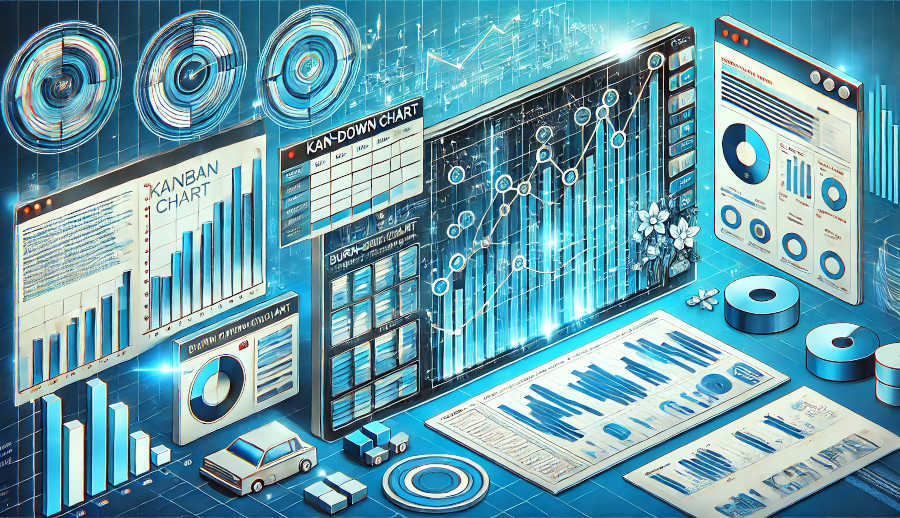The process of drawing a burn-down chart may seem daunting at first, but it can be broken down into manageable steps. From defining the scope of work to plotting the data and interpreting the results, each step plays a crucial role in ensuring the chart's accuracy and usefulness. This article will guide you through the entire process, from zero to mastery, helping you understand not only how to create a burn-down chart but also how to leverage it for improved project outcomes.
Understanding the Basics of a Burn-Down Chart
Before diving into the creation process, it’s essential to understand what a burn-down chart is and why it’s valuable. A burn-down chart is a graphical representation that shows the amount of work remaining over time. The vertical axis represents the amount of work, often measured in story points or hours, while the horizontal axis represents time, typically in days or sprints. The chart includes two lines: the ideal burn-down line, which shows the expected progress if work is completed at a steady pace, and the actual burn-down line, which reflects the real progress of the team.
The primary purpose of a burn-down chart is to provide transparency and facilitate communication within the team. It allows everyone to see whether the project is on track, ahead, or behind schedule. By visualizing the remaining work, team members can identify potential issues early and take corrective actions. Additionally, the chart serves as a motivational tool, as it provides a clear sense of accomplishment as the work is completed and the line moves downward.
To create an effective burn-down chart, it’s crucial to start with accurate data. This includes a clear understanding of the total scope of work, the team’s capacity, and the timeline. Without these foundational elements, the chart may not provide meaningful insights. Once the basics are in place, the next steps involve plotting the data and interpreting the results, which we’ll explore in the following sections.
Preparing the Data for the Burn-Down Chart
The first step in creating a burn-down chart is to gather and organize the necessary data. This includes the total amount of work to be completed, the team’s capacity, and the timeline for the project. The total work is often represented in story points, which are units of measure used in Agile methodologies to estimate the effort required for tasks. Alternatively, hours or tasks can be used, depending on the team’s preference and the nature of the project.
Once the total work is determined, the next step is to calculate the team’s capacity. This involves understanding how much work the team can realistically complete in a given time frame, such as a sprint or a week. The capacity is influenced by factors such as team size, individual skill levels, and external dependencies. Accurately estimating the team’s capacity is critical, as it directly impacts the slope of the ideal burn-down line and the accuracy of the chart.
With the total work and team capacity defined, the next step is to establish a timeline. This involves dividing the project into smaller time increments, such as sprints or days, and plotting the expected progress for each increment. The ideal burn-down line is then drawn, showing a straight, downward slope from the total work at the start to zero at the end of the timeline. This line serves as a benchmark against which the actual progress can be compared.
Plotting the Burn-Down Chart
Once the data is prepared, the next step is to plot the burn-down chart. This involves creating a graph with time on the horizontal axis and work remaining on the vertical axis. The ideal burn-down line is drawn first, starting at the total work on day zero and ending at zero on the final day. This line represents the expected progress if the team completes work at a steady pace.
Next, the actual burn-down line is plotted. This line is updated daily or at the end of each sprint, reflecting the real progress of the team. To plot the actual line, the remaining work is calculated by subtracting the completed work from the total work. The points are then connected to form a line that may or may not align with the ideal burn-down line. Deviations from the ideal line provide valuable insights into the team’s performance and the project’s status.
The actual burn-down line can take various shapes, depending on the team’s progress. A line that closely follows the ideal burn-down line indicates that the team is on track. A line that is above the ideal line suggests that the team is falling behind, while a line below the ideal line indicates that the team is ahead of schedule. By analyzing these patterns, project managers can identify potential issues, such as scope creep, underestimated tasks, or resource constraints, and take corrective actions.

Interpreting the Burn-Down Chart
Interpreting the burn-down chart is a critical step in leveraging its full potential. The chart provides a wealth of information about the project’s status and the team’s performance. One of the key aspects to look for is the slope of the actual burn-down line compared to the ideal burn-down line. If the actual line is steeper than the ideal line, it indicates that the team is completing work faster than expected. Conversely, a shallower slope suggests that the team is progressing slower than planned.
Another important aspect to consider is the presence of plateaus or spikes in the actual burn-down line. Plateaus, where the line remains flat for several days, may indicate that the team is facing obstacles or that tasks are taking longer than expected. Spikes, where the line suddenly increases, may suggest that new work has been added to the scope or that completed work has been reassessed. These anomalies provide valuable clues about potential issues that need to be addressed.
Finally, it’s essential to use the burn-down chart as a tool for communication and collaboration. Regular reviews of the chart during team meetings can help ensure that everyone is aligned and aware of the project’s status. By discussing deviations from the ideal burn-down line and exploring their root causes, the team can identify solutions and make informed decisions to keep the project on track. This collaborative approach not only improves project outcomes but also fosters a sense of ownership and accountability among team members.
Conclusion
Mastering the art of creating and interpreting a burn-down chart is a valuable skill for any project manager or team member. By following the steps outlined in this article, from understanding the basics to plotting and interpreting the chart, you can gain better control over your projects and improve your team’s performance. The burn-down chart is more than just a visual tool; it is a powerful instrument for fostering transparency, communication, and continuous improvement.
As you become more proficient in using burn-down charts, you’ll find that they provide not only a snapshot of the project’s status but also insights into the team’s dynamics and workflows. By regularly reviewing and updating the chart, you can identify potential issues early, make data-driven decisions, and ensure that your projects stay on track. Ultimately, the burn-down chart is a testament to the importance of visualization and collaboration in achieving project success.
In conclusion, the burn-down chart is an indispensable tool in the project manager’s toolkit. Whether you’re managing a small team or a large, complex project, the chart can help you stay organized, focused, and aligned with your goals. By mastering the steps of creating and interpreting a burn-down chart, you can elevate your project management skills and lead your team to success.
FAQ
1.What is the difference between a burn-down chart and a burn-up chart?
A burn-down chart focuses on the amount of work remaining over time, showing a downward trend as tasks are completed. In contrast, a burn-up chart tracks the amount of work completed over time, showing an upward trend. Burn-up charts are useful for visualizing scope changes, as they clearly show when new work is added to the project.
2.How often should a burn-down chart be updated?
A burn-down chart should be updated regularly, typically at the end of each day or sprint. Frequent updates ensure that the chart accurately reflects the team’s progress and provides timely insights for decision-making.
3.Can burn-down charts be used for non-Agile projects?
Yes, burn-down charts can be adapted for use in non-Agile projects. While they are most commonly associated with Agile methodologies, the principles of tracking remaining work and visualizing progress are applicable to any project management approach. The key is to tailor the chart to the specific needs and terminology of the project.
ARTICLE TITLE :Detailed explanation of the steps of drawing a burn-down chart: from zero to mastery ,AUTHOR :ITpmlib

















